WORLD CLASS COACHING
Club Curriculum Building a Better Goalkeeper
By Tony Englund
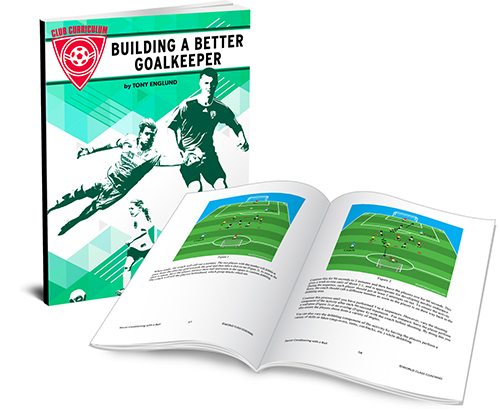
TABLE OF CONTENTS
Part Four
TRAINING SESSIONS
ABOUT THE AUTHOR
Training Session#9: Reaction Saves
Introduction: Goalkeepers tend to like to work on reaction saves in part because the training can be very lively and challenging and in part because these saves often end up being more spectacular. Just as field players work on speed of play, goalkeepers, even at young ages, work on their ability to adjust quickly to sudden attempts at goal. For young goalkeepers, this training sharpens their motor skills, agility and their ability to control the ball under pressure.
Classic Reactions Catching
This series is useful for providing very quick repetition. The goalkeepers work through the progression below in pairs, alternating roles every 10 shots. In each case, vary serves – thrown, punted, drop-kicked, shot from ground. The major coaching points with reactions work are enforcing the importance of good hand-eye coordination and extending the catching area to reduce the number of rebounds.
• Goalkeeper looks down; partner calls, “Shot!” and she reacts to save.
• Goalkeeper faces away from her partner. At the call of, “Shot!,” she turns and reacts to save.
• Goalkeeper starts on the post, facing the corner flag. At the call of, “Shot!,” she turns to deal with shot from her partner in the area.
• Goalkeeper starts laying on her front side and looking down. At the call of , “Shot!,” she recovers and reacts to save.
• Goalkeeper starts laying on her back and looking up. At the call of, “Shot!,” she recovers and reacts to save.
Drop and Catch
This is another traditional exercise for goalkeepers to practice their ability to suddenly save. There are many variations, but generally one goalkeeper holds the ball with both hands at chest height to begin (hands on the underside of the ball). Her partner stands facing her and places her hands above the ball. When the holder releases the ball, the goalkeeper reacts to catch before the ball reaches ground. Change roles after 30 seconds.
Variations/Progression
• The holder fakes to drop.
• The holder holds the ball at waist height.
• The active goalkeeper must begin with her hands behind her back.
• Utilize two balls (drop one).
• Utilize two balls and the server holds her hands straight out at her sides and shoulder high – as she drops one, the goalkeeper must dive to save before the ball hits the ground or to cover the bounce.
Toss-Save-Catch
Each goalkeeper holds a ball. One goalkeeper tosses her ball in the air, receives a chest pass from her partner and returns, and then relocates and saves her original toss. Change roles after each sequence. This is a particularly useful exercise for younger goalkeepers in that it helps them learn to locate a ball in the air.
Variations
• The server from the partner is a shot played with pace from the feet.
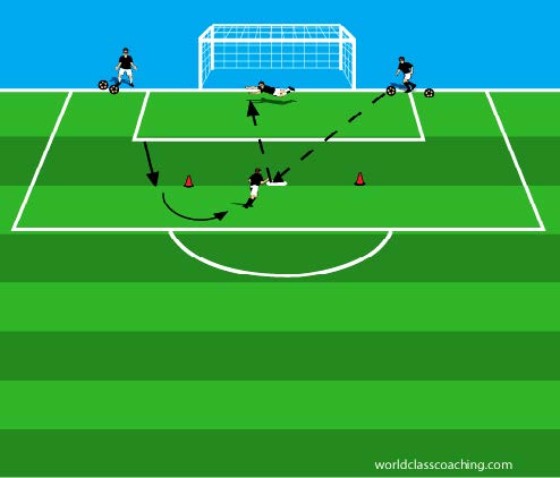
Pass-Shoot-Play Goalkeeper - Goal and box area
Place one cone 12 yards from each post as shown. Divide the players into two groups. Players first pass to a player in the opposite line, then run around the cone and shoot first time at goal and finally play goalkeeper for the next shot before retrieving a ball and returning to their line. Because the shots are taken from fairly close in (adjust the distance to challenge but not overwhelm goalkeepers), goalkeepers will be able to sharpen their ability to make reaction saves.
Coaching Points
• Goalkeepers should be set (feet stopped, weight slightly forward) when the ball is struck.
• Encourage goalkeepers to challenge shooters by moving off or their line toward the shooter a few steps to cut down the shooting angles available to the shooter.
Training Session#10: Angle Play and the Goalkeeper’s Role in Team Defense.
Introduction
Although the tactical role and the importance of angle play are limited for U9/U10 goalkeepers (small goals and fields), it can be useful to share the basic tenets of both areas with young goalkeepers because at U11/U12, the goal and field get much bigger and both elements are magnified in importance. This session presents easy ways to get young players to think about angle play and also their role in playing behind the defense if they’re in goal.
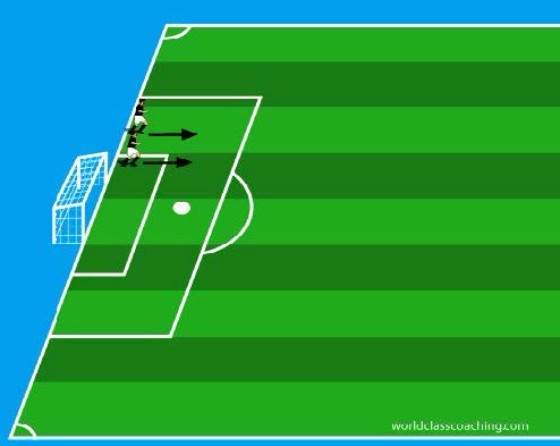
Box Warm-up Runs
Footwork inside the large goal box. This is also a good foot work warm-up for the goalkeeper on game day. This warm-up offers the added benefit of allowing the goalkeeper time to get comfortable in the goal box area.
Progression
• Jog out, jog back; jog out, jog back.
• High knees out, high knees back.
• High heels out; high heels back.
• Shuffle out, shuffle back..
• Jog out, backpedal back.
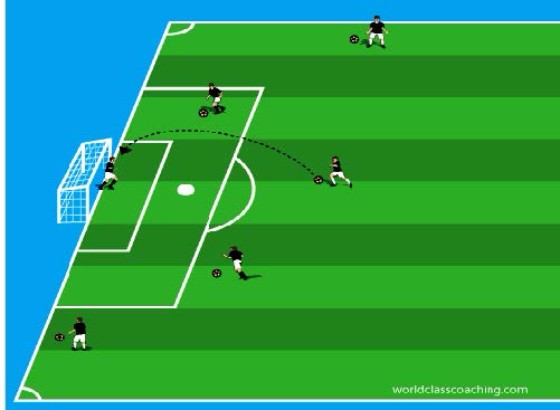
Angle Shooting - ½ field
The goalkeeper is in the goal. All other players have a ball and are stationed randomly throughout the near end of the field (vary both distance and angle). The goalkeeper calls out names of players who take a touch and shoot. Players stationed beyond their shooting range can punt balls into the area for the goalkeeper to recover. Each time the goalkeeper gets set before a shot, the coach can help adjust her position.
Coaching Points
• Goalkeeper recognition of distance. For U9/U10 goalkeepers, the likelihood of being chipped is minimal and they can play aggressively within their area. For U11/U12 goalkeepers, they need to stay relatively close to their goal if the ball is near the area (large box) or just inside the area, as the possibility of a high shot catching them off of their line is very real). For shots inside the area at U9/U10 and from within 12 yards for U11/U12 goalkeepers, the ‘keeper must step out aggressively to challenge the shooter and cut angles to the goal.
• Goalkeeper recognition of angles. Again, the U9/U10 goal is small enough where angles, while useful, are not as critical as at the older ages. Encourage goalkeepers to step out of the goal slightly to remove the fear and danger of diving or moving into a post while making a save. Also explain that as a rule it is important to take away the near post while allowing oneself an opportunity to still save balls shot at the back post as well. Finally, from sharp angles (near the corners), U11/U12 goalkeepers should play nearer the middle of the goal (to deal with a long cross) on balls served from distance and then actually get beyond the post (to the ball) for shots in close.
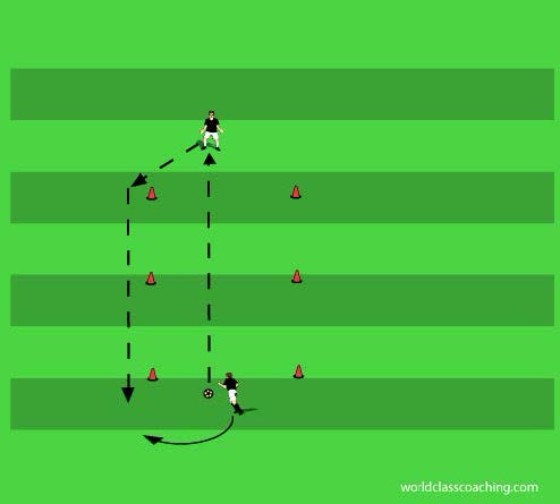
Back Passes in a Grid - 12x6 yard grid
The most decisive change in the tactical role of the goalkeeper in recent years has been the evolution of the goalkeeper as a significant source of pressure release for the defense and an organizer for team possession. Consequently, the goalkeeper’s ability to receive and play with her feet is now a mandatory consideration for coaches. For young teams, it is very helpful to add in the option for a pressured defender facing her own goal to pass to her goalkeeper (when it’s safe to do so!) to relieve pressure. In this exercise, the goalkeepers serve balls through the lane to one-another and the receiving goalkeeper focuses on changing the direction (sharply) of the ball with her first touch and distributing with her second touch.
Additional coaching points
• Utilize both the inside and outside surfaces (and alternate feet) to receive.
• Shorten the time between the first and second touches.
• Require the receiving goalkeeper to ask for (demand) the ball before it is played. This restriction both builds in the requirement that the pass be a safe one (the goalkeeper’s prerogative) and also helps demonstrate the importance of goalkeeper communication.
Progression
• Serves in the air and on the bounce (no hands to receive)
• Tosses to be headed back (change the angle of the ball with the header and head high to clear).
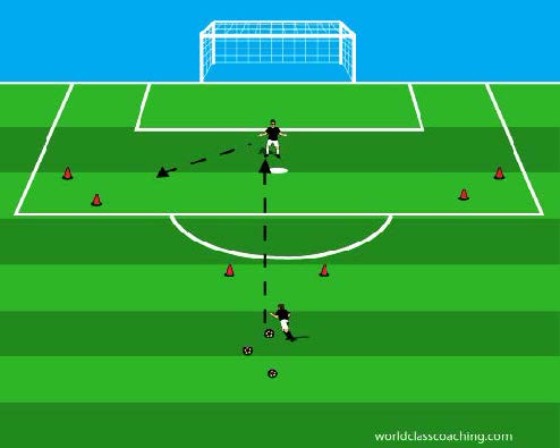
Back Passes and Pressure Clearances - Edge of the large goal box
The server plays balls through the central cone goal and becomes a target for distribution through the goal chosen by the goalkeeper. The working goalkeeper receives and distributes (2-touch) through either of the side goals. Once again, the goal is to play quickly and with a sharp first touch in particular.
Progression
• The server indicates which side (hand signal) the working goalkeeper must receive and distribute to.
• The server plays through a side goal and the working goalkeeper must work all the way across to the far goal to distribute.
• Bouncing and flighted serves. Encourage the goalkeeper to work with the edge of the area in mind (if she plays outside that area, she cannot use her hands).
• The server indicates at the moment of the pass whether the pass is from the goalkeeper’s team or from the opponents (if from the opponents, she can pick it up with her hands inside the area). Play some serves slowly and indicate that they are from the opponent (show that the goalkeeper can then dribble the ball back into the area and pick it up with her hands).
• The server follows her pass and pressures the goalkeeper. Play some serves slowly and do not press (show that the goalkeeper can then dribble the ball back into the area and pick up with her hands).
Training Session#11: Breakaways.
Introduction
The breakaway situation is one of the most challenging for goalkeepers of any age and by U11/U12 in particular, players need to be instructed as to how to deal with a single attacker in alone.
This session gives a buildup to and efficient training in dealing with the breakaway situation.
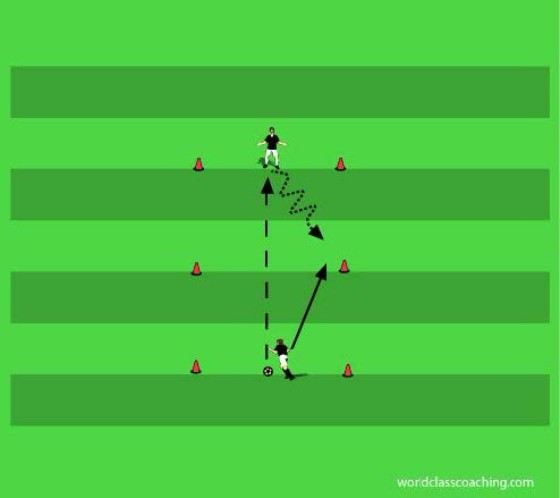
Closing Down and Smothering in a Lane - 6x12 yard lane
An environment used to train goalkeepers to deal with break-away situations, the lane is used to limit the options of the attacker and allow the goalkeeper to refine timing and technique in these situations. The goalkeepers begin on opposite ends of the lane. The goalkeeper with the ball passes to her partner, who becomes the attacker, and then closes down. Adjust the size of the lane to reflect the ability and experience of the goalkeepers.
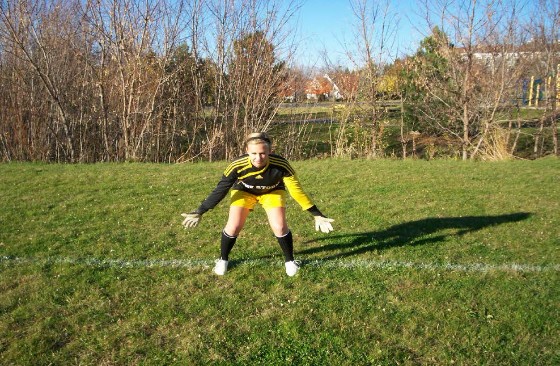
The goalkeeper should adopt a crouched ready position (with the hands out at the sides and low, as there is less concern about rebounds here and more focus on just blocking the ball), and use a couple larger steps to close the space. Then she switches to short steps (easier to adjust). Once in close, the goalkeeper looks for a touch by the attacker that would allow her to smother (block) the ball. Change roles after each save.
Coach blocking
• Similar to collapse diving. Goalkeeper gets close to the ball and then pushes down onto her side (outside of knee, hip and shoulder are contact points). Reach the hands to the ball (take the ball away from the attacker) with one hand well in front of the face and one reaching to get on top of the ball. Arms are bent (like springs) to absorb a kick from the attacker if necessary.
The most common errors here are:
• Goalkeepers leaving their feet too early.
• Approaching straight on, which makes it difficult to get hands to ball while getting into a blocking position.
• Leading with the feet (creates rebounds, fouls and no chance for recovery).
To begin, the attacker makes it easy for the goalkeeper to take the ball.
Progression
• The attacker moves full speed but cannot shoot (must dribble past the goalkeeper if possible).
• Next, the attacker fakes a shot (forces the goalkeeper to set her feet to deal with the potential shot) and then returns to the attack.
• Finally, the attacker has no restrictions other than that she must play full speed and cannot stop or turn back.
Breakaway to Goal-1/3 field
Attackers must run at full speed to goal, but otherwise have no restrictions. Goalkeepers are taught to expand their range and understanding in these situations by building on the lessons learned in the build-up exercise above. Because the distance is greater, it is important for the goalkeeper to recognize a breakaway situation immediately and start to close down the attacker immediately.
Coaching Points
• Long strides early to close distance.
• Short steps in close to allow for quick adjustment.
• If the attacker gives indications she will shoot (long touch, looks up and then down, raises heel of shooting foot), the ‘keeper must set her feet.
• Close down and smother the ball, leading with the hands.
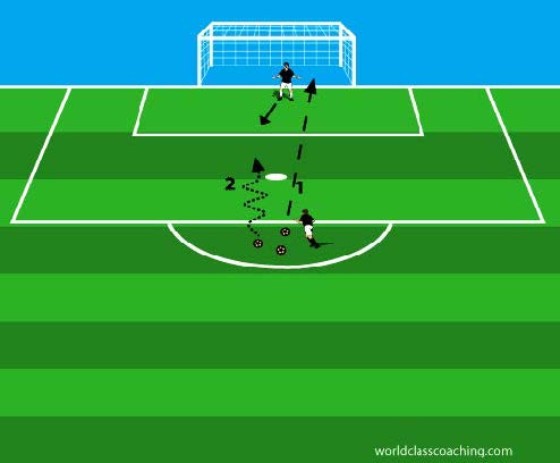
Long Shot Break-Away
After shooting from distance, the attacker runs onto a ball at the top of the 18-yard box and a break-away situation ensues. The goalkeeper must remain near her line to thwart the long shot and then quickly close down on the breakaway opportunity. Change roles after three sequences.
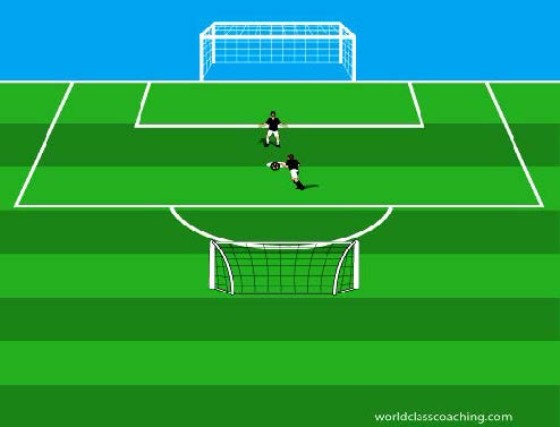
Goalkeeper Challenge
Using two goals (or smaller cone goals) placed 18 yards apart, this is an outstanding environment for goalkeepers to learn to deal with 1v1 situations. Each restart begins with the attacking goalkeeper with one hand on the ball at the center of the area and the defending goalkeeper standing two yards away. As soon as the attacker removes her hand from the ball, play is live, as the attacker attempts to score and the defending goalkeeper attempts to secure control of the ball. This exercise creates coaching and learning opportunities in the areas of angle play, closing down, blocking, covering, shot-stopping, recovery, fitness and more. Moreover, by playing the attacker, goalkeepers develop an advanced understanding of the attacker’s mindset, options and challenges in these situations. When the ball leaves the area, a goal is scored, or the defending ‘keeper gains control, a restart results with the goalkeepers changing roles.
Variations
• Play is live off of turnovers. This rule change speeds up play but also detracts from the structure and focus gained through the set restart.
Training Session#12: Defending Set-Pieces
Introduction
The primary role of the goalkeeper at set-pieces (free kicks and corner kicks) is to focus on the ball and, if necessary, make a save. However, goalkeepers, by their position, have the best view of the field and they also, as they grow older, develop a leadership role. This responsibility includes motivating and organizing the team to defend the set-piece intelligently and aggressively. This session includes diagrams showing, both at U9/U10 and at U11/U12, recommended set-piece defending.
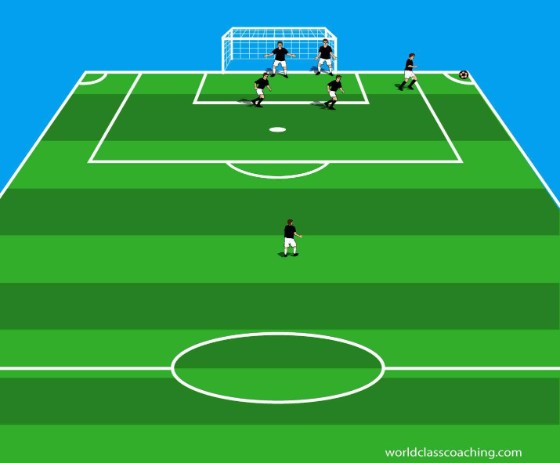
U9/U10 Defending Corner Kicks
Defending corner kicks at these ages presents an opportunity to teach the players about thinking about defending as a group. In the example above, a defender stands at the near post. Her responsibility is to send away any ball that is played directly into her space from the corner. The other defender marks the nearest opponent (goal-side) in the box area, and the midfielder(s) do the same.
The goalkeeper’s focus is to first assure that all of her teammates are dealing with the most dangerous opponents and then to make an early decision as to whether she will play the ball (call ‘keeper!’) or if the defense must clear the ball (call ‘away!’). Note that a forward is sent to the corner to deal with any short corner attempt by the opposition and perhaps knock down any effort by the kicker to serve the ball before goal. The general notion here is to teach young players to want to get the first touch in this situation and for the group to work together to clear the ball and move forward as a team.
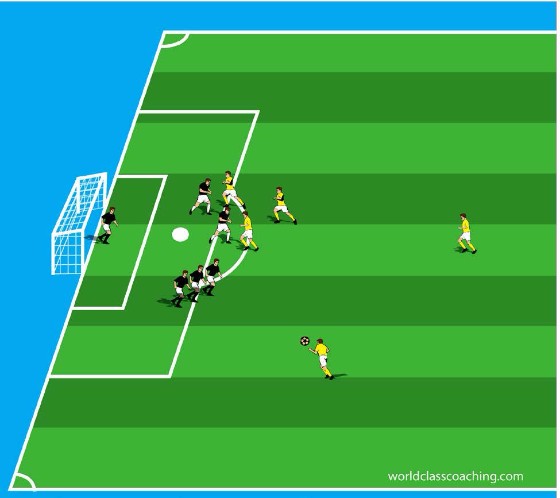
U9/U10 Defending Indirect Free Kicks
The spot of the restart affects the team’s response. In the attacking half of the field, the team all get goal-side and mark opponents. In the defending half, if a shot is a possibility, 2-3 players form a wall (based on the near post) and the goalkeeper marks the back half of the goal. The other players mark the opposing players nearest the goal.
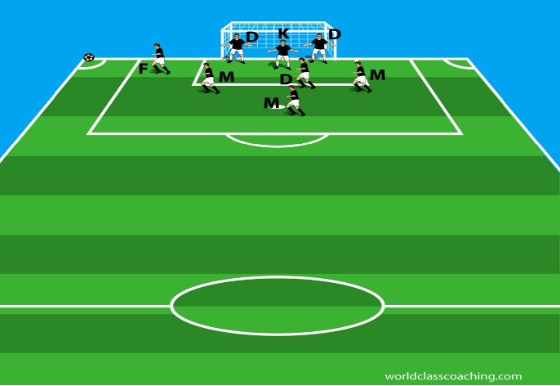
U11/U12 Defending Corner Kicks - 1/3 field
Corner kicks offer a very strong chance to score at any level, and the coach preparing her team to defend in these situations must first answer several important questions:
1. Will the team employ zone or man-marking or a mix?
2. How many players will defend?
3. How well does the team defend in the air (the answer to this question impacts the answer to #2)?
4. How big an area can be assigned to the goalkeeper (i.e. how strong is the goalkeeper in the air and handling the ball in traffic)?
5. Other considerations (opponents’ efficiency at corners, weather, game situation).
Recommendation
• deploy a mix of zonal defending and man-marking as shown, placing players at each post (note the near-side defender’s up-field-facing position before the kick, freeing the goalkeeper’s vision. If instructed to clear the ball by the goalkeeper, she steps out and plays the ball away); the center back and the goalkeeper to control the six-yard box; the three midfielders are placed in a stacked zone across the top of the six-yard box. Any ball that would fall in front of any one of them is their responsibility. The forward is responsible for dealing with any potential short corner (many teams send one player to the corner to deal with this possibility and distract the kicker. It’s even better to send a second player- a midfielder- to play 2 vs. 2 against a short corner). A midfielder can be detailed to mark a particularly dangerous opponent.
• train a confident, aggressive mentality into the group for defending corners. Playing passively will lead to goals being conceded, whereas a loud, active and determined defending group provides an intimidating environment for the attackers and also gives the defenders a psychological sense of purpose.
• clearing out. The team hunts the ball once the serve is struck. When the ball is played away from the goal, all but the two backs on the posts must pursue and pressure the ball. When the ball leaves the box, the two players on the posts sprint forward. Keeping them in gives extra protection in the goal area while the ball is still in a dangerous position. However, when the ball leaves the area, the danger decreases and the retention of those players on the posts both eliminates the possibility of an offside call against the attackers and detracts from the width of the defensive back line in transition.
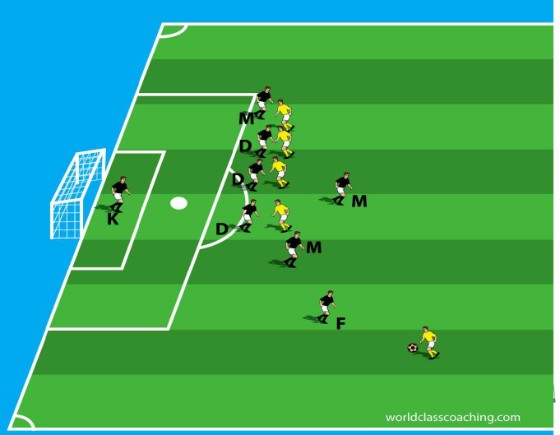
Defending Direct or Indirect Free Kicks: Beyond Shooting Range - 2/3 field
When the opponent earns a free kick from beyond shooting range, the defending group may still employ a small wall (1-2 players) to distract the server and additional players may remain in the area to deal with short options for the attackers. The remainder of the team organize a restraining line to develop space for the goalkeeper to handle a long serve toward the area. Players along the restraining line should get shoulder-on with an attacker, with the idea that the contact will wreck the timing of their run into the area and also allow the defender to arrive first. If possible, at least one central defender should be left free.
Some teams, particularly at the youth level, prefer to have this player leave the line and run into the area just before the ball is struck to give the player an advantage in the race to the ball. This decision may wreck the offside protection offered by holding the line, but it also gives the defender a major advantage. Regardless, the goalkeeper must make an early call as to whether she will handle the ball or if the team will need to clear the serve, and once the ball is cleared, the entire team must work to get forward and recover their shape as quickly as possible.
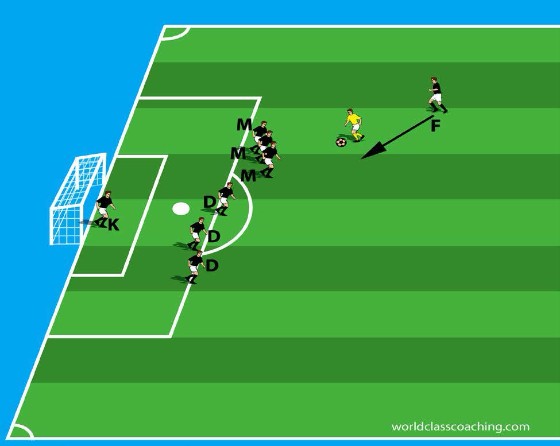
Defending Direct or Indirect Free Kicks: Shooting Range - 1/3 field
Direct free kicks from around the edge of the 18-yard box and at angles where shots can be taken require special treatment from a defensive perspective. The coach should give parameters for the number of players to be placed in the wall (from 1-2 for wide angles and up to 4-5 for shots from straight on). Typically the midfielders and/or forward(s)form the wall.
The coach can instruct the goalkeeper to arrange the wall or a forward can perform the same duty so that the goalkeeper can focus exclusively on the ball. Either way, the wall should be arranged with the tallest player on the near post (this area is most in danger, as the goalkeeper begins in the back half of the goal) and shorter players filling out the line. It is critical that the coach work out the process for the placement of the wall so that it can be done in just a few seconds under pressure. If the goalkeeper will set the wall, the end player (tallest) should either turn and face her or look over her outside shoulder to see her instructions, all the while grasping the next player in the wall to assure that movement is synchronized.
The end player, as a rule, should be at least the width of one person outside the post to deter attempts to bend the ball around the wall. The defenders mark opponents around the wall, picking up the most dangerous players first and holding a line nearly as high as the wall itself (to minimize traffic for the goalkeeper in trying to make the save).
Tactical considerations
• in the modern game, most defending teams put a player(s) 2-3 yards in front of the ball to wreck any idea of taking the kick before the wall can be set. By the rules of the game, this is meant to be rewarded with a yellow card, but it is almost universal that there is no card and the attacker requests the proper 10-yard spacing. Once the official steps in to set the wall at the proper distance, play is only restarted with the referee’s whistle.
• use of a ‘bullet.’ Although more common in indirect free kick situations, some teams send a player off of the end of the wall running at the ball (‘bullet’) just before it is struck. Once again, technically-speaking this should result in a yellow card, but most often it results in a blocked kick. Many coaches only employ a ‘bullet(s)’ only in indirect kick situations.
U11/U12 Indirect Free Kick in the Area - 18-yard box
Occasionally, a team will concede an indirect free kick in the area. This is a very dangerous situation, particularly if the placement of the ball is close to the goal mouth (as shown). In this case, many coaches place the entire team on the goal line, splitting the wall around the goalkeeper. Remind players that since this is an indirect kick situation, the opponents will need to take a touch before shooting. When that first touch is taken, the entire wall (some coaches leave players on the posts) sprints forward, keeping in their lanes, hoping to block the shot. Indirect kicks from sharp angles can be played more like a corner kick, with defenders on the posts and a combination of zone an man-marking in front of goal.
Conclusion
Coaching goalkeepers is often a source of discomfort for soccer coaches at any age. The distinctive skill set, the tactical requirements and mental approach required to become a good goalkeeper are not a common ingredient in standard coaching education and can be particularly daunting for new coaches of young players. Many coaches struggle with finding the time and means to work with their goalkeepers (or, if the team rotates everyone through the goal, finding time to train the team in goalkeeping basics) even if they have a good idea of how to train goalkeepers. Yet virtually everyone would acknowledge that to not train goalkeeping and goalkeepers is to court certain chaos in the goal on game day.
This program is intended to be a bridge for everyone from the club goalkeeping specialist looking for curriculum to the coach of young players who wants to work with his/her goalkeepers in and out of training in brief, efficient sessions, and also for the parent who wants to help their child learn more about the goalkeeping position.
Playing goalkeeper in the pre-teen years is highly beneficial for children not only to learn about goalkeeping in case they decide or are needed to play goalkeeper permanently as they mature, but also because experience in goal helps players understand much more about the game and the challenges and rewards of playing the position.
Sources and Recommended Reading
NSCAA. Goalkeeping Level 1 Diploma. Course materials.
NSCAA. Goalkeeping Level 2 Diploma. Course materials.
NSCAA. Goalkeeping Level 3 Diploma. Course materials.
Tony Di Cicco. Proper Goalkeeper Match Warm-up. Field session.
Peter Greiber and Robert Freis. The Complete ‘Keeper.
Maarten Arts. The Soccer Goalkeeper Coach.
Tony Englund. Keeper Wars: Goalkeeper Training in a Competitive Environment.
About the Author
Tony Englund is the Assistant Director of Coaching at St. Croix Soccer Club. Tony has earned more than a dozen diplomas from the National Soccer Coaches’ Association of America, including the Premier, National Goalkeeping and Director of Coaching awards and he serves as an Associate Staff Coach for that organization. Tony is a frequent presenter at high-level coaching clinics. He has served as Director of Coaching and Player Development with three Minnesota clubs and has more than twenty years’ experience as a successful club, high school and college head coach. His teams have repeatedly earned promotion to the highest levels of state and Midwest Regional League play and won multiple state championships, premier league titles and consistent regional rankings. He is the author of nine books published by WORLD CLASS COACHING.


